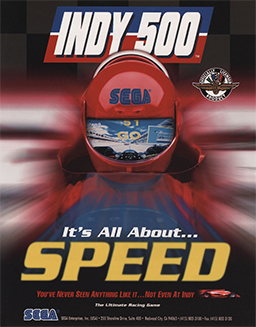Indy 500 (1995 video game)
| Indy 500 | |
|---|---|

Arcade flyer for Indy 500.
|
|
| Developer(s) | Sega-AM1 |
| Publisher(s) | Sega |
| Platform(s) | Arcade, Game.com, R-Zone |
| Release | July 15, 1995 |
| Genre(s) | Racing game |
| Mode(s) | Single-player, multiplayer |
| Cabinet | Sit down cabinet |
| Arcade system | Sega Model 2 |
| Display | Raster 496 x 384 pixels (Horizontal), 8192 colors |
Indy 500 is a 1995 arcade racing video game developed by Sega's AM1 division and published by Sega Enterprises. It follows the format of previous driving games such as Daytona USA. It includes the famous Indianapolis 500. It was originally being developed for the Sega Model 3 arcade board, but due to delays in the board's development it was instead released on the Sega Model 2 B CRX.
Players can race one of three courses: Highland Raceway, Indianapolis 500, and Bayside Street. A disclaimer appears at the start of the game notifying players that Highland Raceway and Bay Side Street are fictional courses and are not affiliated with Indy. However, the two courses resemble Laguna Seca and Long Beach/Surfers Paradise respectively.
The race commences after the user has made their choice of automatic transmission or manual transmission with a 2-position shifter. Special features of the cabinet include a steering wheel with haptic feedback. The development team behind the Sega Saturn version of Sega Rally Championship were planning to do a Saturn conversion of Indy 500, but due to fan demand they were taken off of the project and put to work on Daytona USA: Championship Circuit Edition instead. However, Indy 500 is emulated on the Model 2 Emulator by Elsemi.
Sega World Sydney featured an enhanced version of Indy 500 similar to Virtua Racing at the Yokohama Joypolis and Sega Touring Car Championship at the Tokyo Joypolis. It featured an 8 player linked system with large screens in front of complete cockpits including additional virtual spectator displays. It was run as an attraction, as opposed to regular arcade units, which involved continuous staffing and requiring players to queue. This variation still exists at several current and former Sega GameWorks video game arcades in the United States of America.
...
Wikipedia
